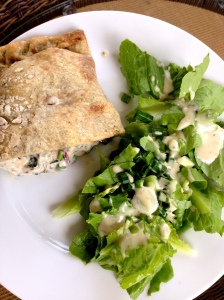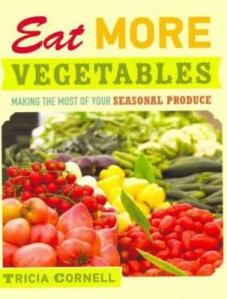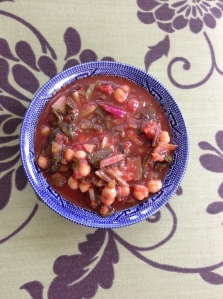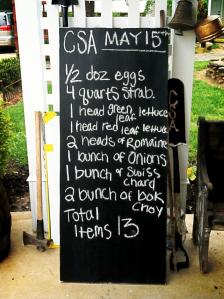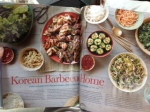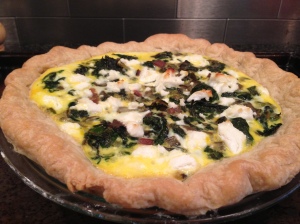My approach to CSA cooking is usually to try to use as few non-CSA ingredients as possible, since that helps you get the most bang for your buck from your CSA share. I don’t want to have to spend a lot of money on exotic ingredients to make fancy recipes on Epicurious or Pinterest, so I usually modify them to use what I have.
I wrote last year about how homemade pizza can be a CSA member’s best friend. You can find my go-to easy weeknight pizza dough recipe here. Tonight, I used half of that recipe to make this calzone, which I told my 3-year-old daughter, is just a pizza turned inside-out. You could use any store-bought pizza dough or your own favorite recipe to do this.
There is no need to be too exact with this. If you have sausage or mushrooms around, they would be great in here. You just don’t want to increase the total quantity of filling too drastically, so cut down on other ingredients before adding new ones. I would also recommend dividing your dough in half (or into parts small enough to make individual calzones) to make these neater and more hand-held. If you do this, divide your dough when you take it out of the fridge, because then each little piece will have time to come to room temperature and rise on its own. I made one big calzone, which came out fine, but I would have liked a little more crust on my piece.
Asparagus and Swiss Chard calzone
Ingredients:
1/2 recipe weeknight pizza dough (or enough of any other dough for a 12″ pizza)
1 tablespoon olive oil, plus more for brushing the crust
2 green onions, green and white parts chopped
2 cloves garlic, minced
1/4 teaspoon crushed red pepper
1/2 bunch Swiss chard, torn into pieces, stems separated from leaves and chopped finely, leaves chopped coarseley
1/2 pound asparagus, chopped into thin discs
3/4 cup ricotta cheese
3/4 cup shredded mozzarella cheese
2 tablespoons shredded parmesan cheese
1/4 teaspoon salt
1/4 teaspoon pepper
1/2 teaspoon dried Italian herbs (I like the frozen pizza mix from Penzey’s)
Make your dough or take pre-made dough out of the refrigerator in the morning, and let it sit at room temperature on a floured cutting board covered by a clean kitchen towel all day. Divide dough into desired number of pieces when you take it out and let each piece rest separately.
Heat oil over medium-high heat and cook onions and garlic with crushed red pepper until translucent, about 3 to 5 minutes. Add chard stems and cook another few minutes, then add chard leaves and cook until wilted. Allow this mixture to sit until it’s cool enough to handle. Gently squeeze as much liquid out of the chard as you can and place it in a bowl with the asparagus, cheeses, salt, pepper and herbs. Mix until well-blended.
When ready to make the calzones, preheat oven to 450 degrees. Line a large cookie sheet with foil and coat with cooking spray. Gently shape your dough pieces into circles about half a centimeter thick. It’s best to do this on your floured cutting board. Then place each piece of dough so that half of it lies on the cookie sheet and half flops off (or whatever arrangement you need to fit them all one one sheet, keeping in mind that the finished product will be folded in half). Lightly drizzle each dough round with olive oil (I find this makes for a crisper crust.).
Divide the cheese mixture among your dough rounds. Brush the border of each dough round with water, fold the empty half over and pinch to seal. Using a sharp knife, cut 2-3 holes in the top of each calzone. Brush each one with olive oil. Bake for 15 minutes, or until crust begins to brown and center is bubbly.
Allow to cool 3 to 5 minutes. Serve with a good marinara on the side.

